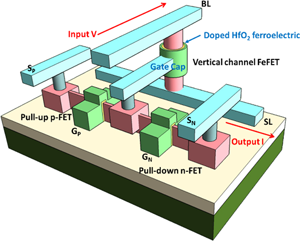Crossref Citations
This article has been cited by the following publications. This list is generated based on data provided by
Crossref.
Yu, Shimeng
Shim, Wonbo
Peng, Xiaochen
and
Luo, Yandong
2021.
RRAM for Compute-in-Memory: From Inference to Training.
IEEE Transactions on Circuits and Systems I: Regular Papers,
Vol. 68,
Issue. 7,
p.
2753.
Breyer, Evelyn T.
Mulaosmanovic, Halid
Mikolajick, Thomas
and
Slesazeck, Stefan
2021.
Perspective on ferroelectric, hafnium oxide based transistors for digital beyond von-Neumann computing.
Applied Physics Letters,
Vol. 118,
Issue. 5,
Yu, Eunseon
Agrawal, Amogh
Zheng, Dongqi
Si, Mengwei
Koo, Minsuk
Ye, Peide D.
Gupta, Sumeet Kumar
and
Roy, Kaushik
2021.
Ferroelectric FET Based Coupled-Oscillatory Network for Edge Detection.
IEEE Electron Device Letters,
Vol. 42,
Issue. 11,
p.
1670.
Hoffmann, Michael
and
Salahuddin, Sayeef
2021.
Ferroelectric gate oxides for negative capacitance transistors.
MRS Bulletin,
Vol. 46,
Issue. 10,
p.
930.
Mikolajick, T.
Slesazeck, S.
Mulaosmanovic, H.
Park, M. H.
Fichtner, S.
Lomenzo, P. D.
Hoffmann, M.
and
Schroeder, U.
2021.
Next generation ferroelectric materials for semiconductor process integration and their applications.
Journal of Applied Physics,
Vol. 129,
Issue. 10,
Majumdar, Sayani
2022.
Back‐End CMOS Compatible and Flexible Ferroelectric Memories for Neuromorphic Computing and Adaptive Sensing.
Advanced Intelligent Systems,
Vol. 4,
Issue. 4,
Han, Genquan
Peng, Yue
Liu, Huan
Zhou, Jiuren
Luo, Zhengdong
Chen, Bing
Cheng, Ran
Jin, Chengji
Xiao, Wenwu
Liu, Fenning
Zhao, Jiayi
Wang, Shulong
Yu, Xiao
Liu, Yan
and
Hao, Yue
2022.
Ferroelectric Devices for Intelligent Computing.
Intelligent Computing,
Vol. 2022,
Issue. ,
Kim, Min-Kyu
Kim, Ik-Jyae
and
Lee, Jang-Sik
2022.
CMOS-compatible compute-in-memory accelerators based on integrated ferroelectric synaptic arrays for convolution neural networks.
Science Advances,
Vol. 8,
Issue. 14,
Sharifullina, Y. I.
Gumarova, I. I.
Mamin, R. F.
and
Nedopekin, O. V.
2023.
Investigation of heterostructures based on hafnium oxide.
Известия Российской академии наук. Серия физическая,
Vol. 87,
Issue. 4,
p.
580.
Yoo, Jaewook
Song, Hyeonjun
Lee, Hongseung
Lim, Seongbin
Kim, Soyeon
Heo, Keun
and
Bae, Hagyoul
2023.
Recent Research for HZO-Based Ferroelectric Memory towards In-Memory Computing Applications.
Electronics,
Vol. 12,
Issue. 10,
p.
2297.
Kim, Diana S.
Watkins, Virgil J.
Cline, Laszlo A.
Li, Jingxian
Sun, Kai
Sugar, Joshua D.
Fuller, Elliot J.
Talin, A. Alec
and
Li, Yiyang
2023.
Nonvolatile Electrochemical Random‐Access Memory under Short Circuit.
Advanced Electronic Materials,
Vol. 9,
Issue. 1,
Byun, Kanghyeon
Choi, Inhyuk
Kwon, Soonwan
Kim, Younghoon
Kang, Donghoon
Cho, Young Woon
Yoon, Seung Keun
and
Kim, Sangbum
2023.
Recent Advances in Synaptic Nonvolatile Memory Devices and Compensating Architectural and Algorithmic Methods Toward Fully Integrated Neuromorphic Chips.
Advanced Materials Technologies,
Vol. 8,
Issue. 20,
Zhang, Miaocheng
Wei, Yixin
Liu, Cheng
Ding, Zixuan
Liang, Xin
Ming, Sen
Wang, Yu
Shao, Weijing
Hu, Ertao
Wang, Xinpeng
Zhang, Yerong
Zhang, Minggao
Xu, Jianguang
and
Tong, Yi
2023.
Perspectives on MXene-PZT based ferroelectric memristor in computation in memory applications.
Applied Physics Letters,
Vol. 123,
Issue. 6,
Moody, Michael J.
Paul, Joshua T.
Smeets, Paul J. M.
dos Reis, Roberto
Kim, Joon-Seok
Mead, Christopher E.
Gish, Jonathan Tyler
Hersam, Mark C.
Chan, Maria K. Y.
and
Lauhon, Lincoln J.
2023.
van der Waals Epitaxy, Superlubricity, and Polarization of the 2D Ferroelectric SnS.
ACS Applied Materials & Interfaces,
Vol. 15,
Issue. 48,
p.
56150.
Kim, Ik-Jyae
Kim, Min-Kyu
and
Lee, Jang-Sik
2023.
Highly-scaled and fully-integrated 3-dimensional ferroelectric transistor array for hardware implementation of neural networks.
Nature Communications,
Vol. 14,
Issue. 1,
Hossen, Imtiaz
Glasmann, Andreu L.
Najmaei, Sina
and
Adam, Gina C.
2023.
Interpolative Device Models for Hafnia-Based FeFETs.
p.
1.
Haensch, Wilfried
Raghunathan, Anand
Roy, Kaushik
Chakrabarti, Bhaswar
Phatak, Charudatta M.
Wang, Cheng
and
Guha, Supratik
2023.
Compute in‐Memory with Non‐Volatile Elements for Neural Networks: A Review from a Co‐Design Perspective.
Advanced Materials,
Vol. 35,
Issue. 37,
Sharifullina, Y. I.
Gumarova, I. I.
Mamin, R. F.
and
Nedopekin, O. V.
2023.
Investigation of Heterostructures Based on Hafnium Oxide.
Bulletin of the Russian Academy of Sciences: Physics,
Vol. 87,
Issue. 4,
p.
504.
Kim, Ik‐Jyae
and
Lee, Jang‐Sik
2023.
Ferroelectric Transistors for Memory and Neuromorphic Device Applications.
Advanced Materials,
Vol. 35,
Issue. 22,
Dahan, Mor Mordechai
Mulaosmanovic, Halid
Levit, Or
Dünkel, Stefan
Beyer, Sven
and
Yalon, Eilam
2023.
Sub-Nanosecond Switching of Si:HfO2 Ferroelectric Field-Effect Transistor.
Nano Letters,
Vol. 23,
Issue. 4,
p.
1395.




